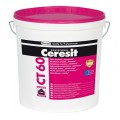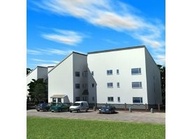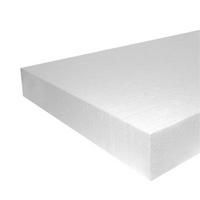Ceresit CT 60 Acrylic Render - Basic Characteristics and Applications
by Mark Row
 Ceresit CT 60 Acrylic Render is, as the name states, a type of render consisted of acrylic resins combined with mineral fillers, affecting its strength, flexibility and resistance. With CT 60 Acrylic Render you get a 1.5 and 2.5 mm dense grain size decorative render, available in over 200 colors, ready and easy to use on a whole set of different surfaces, adding a protective layer to your building thermal insulation often affected by temperature fluctuations and other climate conditions, building location and humidity.
Ceresit CT 60 Acrylic Render is, as the name states, a type of render consisted of acrylic resins combined with mineral fillers, affecting its strength, flexibility and resistance. With CT 60 Acrylic Render you get a 1.5 and 2.5 mm dense grain size decorative render, available in over 200 colors, ready and easy to use on a whole set of different surfaces, adding a protective layer to your building thermal insulation often affected by temperature fluctuations and other climate conditions, building location and humidity.
Render Basics
Before opting for the most suitable render for your home, you need to know the basic differences between available render types, their technical properties, appliance and effectiveness, which will often depend on conditions and structure of the building it is applied on. This is why it is important to know basics on mineral, silicate, silicone, silicone-silicate and mosaic renders.
 Due to their organic bond, acrylic and silicone renders are initially more flexible and have lower shrinkage deformity when compared to mineral and silicate renders. Acrylic and silicone renders high flexibility also makes them more resistant to linear distortions caused by thermal conditions and stresses impact. Unlike mineral and silicate renders which are subject to both structural and surface contamination, acrylic and silicone renders are protected from the dirt migrations, due their sealed polymer structure. Another advantage of acrylic and silicone renders over mineral and silicate renders is their high resistance to discoloration, caused by humidity, since it does not consist of any lime or cement. Also note that if the façade of the building is in any way contaminated, acrylic and silicone renders can be easily cleaned, while mineral and silicate renders need to be repainted. Finally, while mineral renders are only available in white or some pastel shades, acrylic renders, silicate and silicone are, as mentioned before, available in whole set of different colors, making them more diverse, which is even more important knowing that acrylic and silicone renders almost neutral Ph value, makes their color more durable when compared to mineral and silicate renders.
Due to their organic bond, acrylic and silicone renders are initially more flexible and have lower shrinkage deformity when compared to mineral and silicate renders. Acrylic and silicone renders high flexibility also makes them more resistant to linear distortions caused by thermal conditions and stresses impact. Unlike mineral and silicate renders which are subject to both structural and surface contamination, acrylic and silicone renders are protected from the dirt migrations, due their sealed polymer structure. Another advantage of acrylic and silicone renders over mineral and silicate renders is their high resistance to discoloration, caused by humidity, since it does not consist of any lime or cement. Also note that if the façade of the building is in any way contaminated, acrylic and silicone renders can be easily cleaned, while mineral and silicate renders need to be repainted. Finally, while mineral renders are only available in white or some pastel shades, acrylic renders, silicate and silicone are, as mentioned before, available in whole set of different colors, making them more diverse, which is even more important knowing that acrylic and silicone renders almost neutral Ph value, makes their color more durable when compared to mineral and silicate renders.
On the other hand, it is good to know that mineral and silicate renders also have some advantages over acrylic and silicone renders. Firstly, mineral and silicate renders have higher Ph values, unlike acrylic and silicone renders high organic composure, which makes them more susceptible to algae, mold and fungi growth. Mineral renders are also more durable than all silicate, silicone and acryl renders, which are affected by UV radiation, unlike mineral renders which only harden in time. Finally, mineral and silicate renders are more frost corrosion resistant, due to their hydrophobic additives, additionally sealing the render system.
Render description and properties
CT 60 Acrylic Render is available in 25 kg plastic containers, with density of 1.6 kg/dm3, applied in + 5 to +25° C temperatures and preferable humidity below 80%, resistant to rain after approximately 24 hours and with open time of approximately 15 minutes.
CT 60, having a stone like texture is highly flexible, but very resistant to damage at the same time, it is easily adhered to the surface, waterproof and vapor permeable, while its bioprotect formula offers fungus and algae resistance, which is particularly important in places with high humidity.
CT 60 application
 Ceresit acrylic render can be used on different surfaces, including gypsum and concrete substrates, chipboards or traditional renders and are best combined with insulation materials such as polystyrene boards. On the other hand, if you already have an external wall insulation system based on the use of mineral wool insulation products, it is better to go for silicate or especially mineral renders, due to their fire resistance and inflammability.
Ceresit acrylic render can be used on different surfaces, including gypsum and concrete substrates, chipboards or traditional renders and are best combined with insulation materials such as polystyrene boards. On the other hand, if you already have an external wall insulation system based on the use of mineral wool insulation products, it is better to go for silicate or especially mineral renders, due to their fire resistance and inflammability.
Before applying CT 60, make sure that all painted areas are sound enough. This also goes for any contaminants like oil, grease, dirt, dust, fungus or moss that need to be removed prior to application. Also make sure that any existing vapor permeable finishes are properly cleaned.
Always check the weather conditions before applying CT 60 Acrylic Render, since the work should not be done when it is raining, windy or when exposed to direct sunlight, which will affect and possibly prolong the working and drying time. Do not mix the product with other materials and especially avoid water splashes. Simply mix the acrylic render, knowing that the assumed consumption is 2.5 kg/m2 for the 1.5 mm grain size and 3.8 to 4.0 kg/m2 for the 2.5 mm grain size, and apply it evenly to the surface, using stainless steel or plastic tools to avoid corrosion problems. While still wet, the product and its splashes can be removed with clean water, while when already hardened, use only mechanical means for removal. Finally, after applying the product, make sure it is properly protected from the rain until completely dry, always air the room after application and rinse the eyes with warm water in case of a contact, while consulting a doctor.
Feel free to share your opinion on Ceresit renders in the comments section below. I will be happy to answer all your questions



















































































































